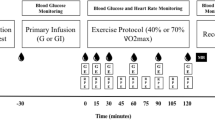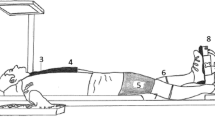Abstract
It seems likely that depletion of body carbohydrates may account for the rise in the sympathetic activity during prolonged exercise, since glucose given during or before exercise reduces the increase in plasma catecholamines. The aim of the present study was to find out whether the increase in plasma noradrenaline (NA) in response to exercise can be reduced by 1. increasing of the amount of carbohydrate available for metabolism without producing hyperinsulinemia and 2. by inhibition of afferent activity from hepatic glucoreceptors. The study was performed on dogs which exercised whilst receiving either the intravenous fructose infusion (2.2 mmol/min) or a slow glucose infusion (0.25 mmol/min) which was given either via the portal or a peripheral vein. Fructose infusion reduced the muscle glycogen depletion during exercise and reduced the increase in plasma NA and glycerol concentrations without altering the blood glucose or insulin levels. The exercise-induced increases in plasma NA and gycerol concentrations were significantly smaller with intraportal than with peripheral glucose infusion but there were no differences between these two cases in the concentration of glucose in the systemic circulation. These findings indicate that the reduction of the plasma NA response to physical effort under conditions of increased carbohydrate availability cannot be attributed to the inhibitory effect of insulin on sympathetic activity and provide evidence for the participation of hepatic glucoreceptors in the control of the sympathetic activity during exercise.
Similar content being viewed by others
References
Anton AH, Sayre DF (1962) A study of the factors affecting the alumine oxide trihydroxyindole procedure for analysis of catecholamines. J Pharmacol Exp Ther 138: 360–375
Bergström J, Hultman E (1969) Synthesis of muscle glycogen in men after glucose and fructose infusion. Acta Med Scand 182: 93–107
Bode C, Schumacher H, Goebell H, Zelder O, Pelzel H (1971) Fructose induced depletion of liver adenine nucleotides in man. Horm Metab Res 3: 38–45
Brzezińska Z, Kaciuba-Uściłko H, Nazar K (1980) Physiological responses to prolonged physical exercise in dogs. Arch Internat Physiol Bioch 88: 285–291
Cousineau D, Perronet F, Picard D, Jachs B, Ledovs M, Nadeau R, Champlain J (1981) Plasma catecholamine response to prolonged exercise after muscle glycogen depletion and overloading. In: Poortmans J, Niset G (eds) Biochemistry of exercise IVB. University Park Press, Baltimore, pp 31–37
Felig P, Cherif A, Minagawa A, Wahren J (1982) Hypoglycemia during prolonged exercise in normal man. New Engl J Med 306: 895–900
Felig P, Wahren J (1979) Role of insulin and glucagon in the regulation of hepatic glucose production during exercise. Diabetes 28, suppl 1: 71–75
Fiorentini A, Müller EE (1975) Sensitivity of central chemoreceptors controlling blood glucose and body temperature during glucose deprivation. J Physiol (London) 248: 247–271
Galbo H, Christensen NJ, Holst JJ (1977) Glucose induced decrease in glucagon and epinephrine responses to exercise. J Appl Physiol: Respirat Environ Exercise 42: 525–530
Galbo H, Holst JJ, Christensen NJ (1975) Glucagon and plasma catecholamines responses to graded and prolonged exercise in man. J Appl Physiol 38: 70–76
Kozlowski S, Brzezińska Z, Nazar K, Turlejska E (1981) Carbohydrate availabilty to the brain and muscles as a factor modifying sympathetic activity during exercise in dogs. In: Poortmans J, Niset G (eds) Biochemistry of exercise IVB. University Park Press, Baltimore, pp 54–62
Krulich L (1961) Demonstration of the reflex character of the hypoglycemia. Physiol Bohemoslov 10: 402–406
Lowry OH, Passonneau JV (1972) A flexible system of enzymatic analysis. New York, Academic Press
McCloskey DI, Mitchell JH (1972) Reflex cardiovascular and respiratory responses originating in exercising muscle. J Physiol (London) 224: 173–186
Mosinger F (1965) Photometric adaptation of Dole's microdetermination of free fatty acids. J Lipid Res 6: 157–161
Nazar K (1971) Adrenocortical activation during long-term exercise in dogs: evidence for a glucostatic mechanism. Pflüger Arch 329: 156–166
Nazar K (1981) Glucostatic control of hormonal responses to physical exercise in man. In: Poortmans J, Niset G (eds) Biochemistry of exercise IVA. University Park Press, Baltimore, pp 188–196
Nazar K, Brzezińska Z, Kozlowski S (1975) Sympathetic activity during prolonged physical exercise in dogs: control of energy substrate utilization. In: Howald H, Poortmans JR (eds) Metabolic adaptation to prolonged exercise. Birkhäuser, Based, pp 204–210
Niijima A (1969) Afferent impulse discharge from glucoreceptors in the liver of the guinea pig. Ann Acad Sci 157: 690–700
Nilsson LH son, Hultman E (1974) Liver and muscle glycogen in man after glucose and fructose infusion. Scand J Clin Lab Invest 33: 5–10
Oomura Y, Ohta M, Ishibashi S, Kita H, Okajima T, Ono T (1978) Activity of chemoreceptors related to the neurophysiological mechanism of feeding. In: Bray G (ed) Recent advances in obesity research. II. Newman Publishing, London, pp 17–24
Pequignot JM, Peyrin L, Peres G (1980) Catecholamine fuel interrelationship during exercise in fasting men. J Appl Physiol 48: 109–113
Perronet F, Nadeau RA, Champlain J, Magrassi P, Chatrand C (1981) Exercise plasma catecholamines in dogs: role of adrenals and cardiac nerve endings. Am J Physiol 241: H243-H247
Russek M (1963) Participation of hepatic glucoreceptors in the control of intake of food. Nature 197: 79–80
Russek M (1981) Current status of the hepostatic theory of food control. Appetite 2: 137–143
Russek M, Grinstein S (1974) Coding of metabolic information by hepatic glucorecetors. In: Myers RD, Drucker-Colin RR (eds) Neurohumoral coding of brain function. Plenum, New York, pp 81–97
Sacca L, Cicala M, Corso G, Morrone G, De Simone A, Trimarco B, Ungaro B (1981) Glucoregulatory response to intravenous fructose administration in the dog. Horm Metab Res 13: 195–199
Sawchenko PE, Friedman MI (1979) Sensory functions of the liver — a review. Am J Physiol 236: R5-R20
Schmidt M (1977) Influences of hepatic portal receptors on hypothalamic feeding and satiety centers. Am J Physiol 225: 1089–1094
Sokoloff E, Fitzgerald GG, Kaufman EE (1977) Cerebral nutrition and energy metabolism. In: Wurtman RJ, Wurtman JJ (eds) Nutrition and the brain, vol. 1. Raven Press, New York, pp 87–139
Sols A, Crane RK (1954) Substrate specificity of brain hexokinase. J Biol Chem 210: 581–595
Stegeman J, Kenner TH (1971) A theory on heart rate control by muscular metabolic receptors. Arch Kreisl-Forsch 64: 185–214
Storlien LH, Bellingham WP, Martin GM (1975) Localization of CNS glucoregulatory insulin receptor within the ventromedial hypothalamic nucleus. Brain Res 96: 156–161
Winder WW, Boullier J, Fell RD (1979) Liver glucogenolysis during exercise without a significant increase in cAMP. Am J Physiol 237: R147-R152
Author information
Authors and Affiliations
Additional information
This work was supported by the Polish Academy of Sciences within the project 10.4.03.1.1
Rights and permissions
About this article
Cite this article
Kozlowski, S., Nazar, K., Brzezińska, Z. et al. Mechanism of sympathetic activation during prolonged physical exercise in dogs. Pflugers Arch. 399, 63–67 (1983). https://doi.org/10.1007/BF00652523
Received:
Accepted:
Issue Date:
DOI: https://doi.org/10.1007/BF00652523




